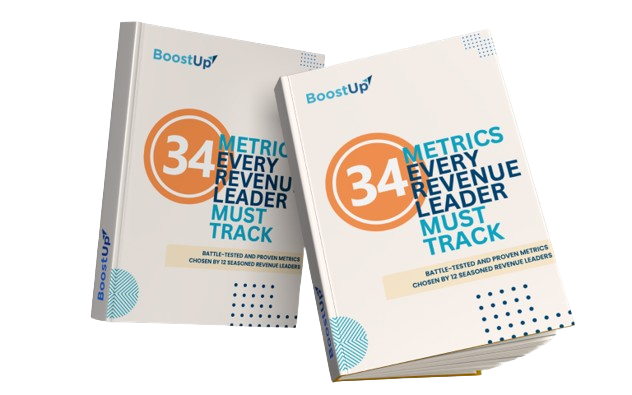But I would argue there's 3 other metrics that you should really tap into that you already have existing relationships with accounts, and therefore, if you make small adjustments, you can really increase your revenue without having to drive more pipeline. So the 3 that I'm going to speak to today is Pipeline Conversion, Pipeline Velocity, and our Win/Loss ratio.
So as you think about pipeline conversion, what it really is, is tracking the number of deals that are moving through the funnel by stage. So you can see that as you move from discovery to close won on the left of my screen, you can see that the percentages vary. And so what I do as a revenue leader is, I calculate these and identify where are the like say, step from demo to proposal, and what that percentage looks like and really start to look at you know, is that an acceptable percentage or not? You know, what can we do to help us as a company do better moving people down the funnel? And then, conversely, we look at it by rep. So where are the reps potentially shortly? Where can we help them through coaching opportunities to be more successful? And so, by looking at a holistic level, we really can focus in on holistic programs that we need to put together to help the conversion percentages and help our accounts move further down the pipeline quicker. But also at the rep level, so we can see which reps are hard performers, which ones that need more training, and where do they need that training? So what this does for me is it helps align marketing and sales to a really tight sales process. It helps me identify what reps need more training. It really helps sales and marketing get that cohesive plan, and that cohesive relationship to figure out where can we best drive pipeline together. And it really looks at the handoffs. So for me being in marketing, it's really important that we look at all the touch points between the moment they come inbound from the SDR to the AE. How does marketing play into that? How do we help enable them to be successful all the way to close won? And so that's why these metrics are so important.
MATT DURAZZANI:
Yeah, what an important metric. I think it's very important, based on what you're saying in particular, as we look at 2023, that everybody wants to drive more pipe. I love the idea that your focussing and saying look you know instead of always going to reinvent the wheel and creating more and more, What have we already created that could be accelerating and recycle, and actually get an ROI for what we already spent on, right. So that's a very good advice. One of the things you made me think of asking is, what trends do you see between the 2 metrics. when you look at the whole pipe versus the reps? Are there any specific flags that you look for? And once you find them, how do you help the reps you know, from this type of insight? And adjusting for 2022 and 23, what type of initiatives do the teams initiate from from this type of information?
BRANDON MOST:
Yeah, it's a great question. So from the rep level, we start to see a lot of trends. And so in our company we've got a lot of new people joining into the ramp time, plays a big key factor into you know how successful these reps are, but what we look to is look at the ones we've been here for you know 6 to 12 months to longer, and see what their average percentages are of moving people down the pipeline, and we kind of map that to where the people who are new or coming in and compare that. What that allows us to do is see kind of where we project these new reps to be in 6 months, but also identifies coaching opportunities, and aligns the high performers potentially to the low performers or to the new reps. So the new rep is having struggle moving people from discovery to demo, let's say we would align them to somebody who's done that very successfully at the company, and start to have coaching opportunities for them to look at. How do we help them be more successful? But also from a marketing standpoint, it's like okay, what are the common objections? What are we not addressing that's moving that deal forward? So how does marketing either create content, programs, sales enablement to help sales ramp faster and be more successful in moving people down the pipeline to shorten that sales cycle.
MATT DURAZZANI:
That's excellent. That's excellent! One last question on this one. aAll of these are fantastic ideas, definitely very good advice, in what type of meetings do you normally discuss this? Do you have a cadence with sales like, and who attends those meetings?
BRANDON MOST:
Have bi-weekly meetings with the Sales leadership team where we start looking at these metrics to start to identify areas in which we could help. And then we have a monthly meeting with kind of the broader SDR management team, marketing and sales team. So we meet twice a month, one at the leadership level, one more at the kind of functional manager level to kind of look at trends, and in each meeting take like 2 or 3 action items for the next meeting. So those are the things we do to try to make sure that we're actionable across the things that we're seeing. Otherwise, If you report on this and do nothing, it's kind of worthless to actually put it together. So it's key to have those action items in those meetings and touch points.
MATT DURAZZANI:
Awesome, thanks for sharing that. Let's go back to the next metric.
BRANDON MOST:
Sure thing Matt. So this is very much correlated to the previous metric, but it's important to look at pipeline velocity, especially for businesses where they're more transactional, but even businesses that have different motions, right. So SMB, mid-market, enterprise, they're going to have different pipeline velocity because some are going to have more touch points, more buyers, longer sales cycles, security might be more involved, procurement might be more involved. So not only do I look at pipeline velocity by stage and rep, which I have here and I'll talk through, but also by the size. So SMB, mid-market, enterprise because they are going to be different, and we can't look at them all holistically together because there are so many differences in the types of companies will be working with those different sizes. But if you look at it by stage, this is really looking at how fast are we moving deals through the funnel, right? So it's kind of like what before was percentage of them, but now we're taking this a step further and saying okay, where are the the the stages where we're spending too much time? Or we need to shrink that down. How do we shrink that down? How do we shrink the overall sales cycle? So where is the hang up? And that's why we would focus in by stage. By rep, it's a similar concept. We've looked at the previous one right, but it's more at the rep level. Where are they struggling? So we looked at it before we're starting to move people down the pipeline. Now we're looking at okay how long is it taking them in different stages to move their accounts down the pipeline. And that's really gives you a good opportunity to look at same things we talked about earlier - coaching opportunities, top performers, things like that. But what this also does is identify errors in which we can provide training, content gaps. really focus in on that sales and marketing alignment that I think most companies strive for, but we're trying to put that into action right. So some of the benefits of looking at some of these things outside of just training and content gaps, and really getting that tight alignment is, it should help improve your win rate, it will accelerate your sales cycle, and it'll help you identify those high and low performers within your organization and identify how do you help them be more successful. Because, as we all know, ramp takes 3 to 6 months of being an organization, You need to get the sales reps you have to ramp quicker than it is to try to replace them if they are high performer. So it's focusing on how do we help them be successful within our organization and maintain them.
MATT DURAZZANI:
Yeah, this is so important.I couldn't agree more with you that you know this, the velocity, of course, is that direct correlation to anything that is conversion right? It's all you look at things side by side to kind of try to understand the full story. I think you brought up a very good point when you said that the pipeline velocity, it needs to be in the right, so to speak, context, to be interpreted right, right? You can just say because you have mid-market enterprise and in other type of areas of the business that you look at the same velocity across the board. So one thought it came to my mind, is situations where you're dealing with executives that are trying to plan for in this case 2023, How do you help them see value, or what type of potential directional advice you provide to the executives from looking at the velocity in the different markets? What kind of ideas come out, typically?
BRANDON MOST:
I think it is critical to look at it holistically, but by the different size of organization, because we all know that there was different complexities in each of those motions, and so they can't be treated the same. So, by breaking those out and focusing in on the different velocity by different regions, the transactional to the longer deals we can really start focusing in on where do we need to focus more of our time and resources? In what motion? If you look at an Enterprise motion, it might be 120 day right versus the SMB at 30 days. Your reps that are more successful, enterprise motion need to be aligned to that. Those are more transactional, we've aligned to SMB: so it's an opportunity to do account planning, It's opportunity to look at which reps are most successful at what selling motion and start into, maybe potentially realign the structure of the team to the successes that they're having as an organization, as an individual. So it just gives us an opportunity to kind of look at how things are performing overall, and make sure that we have the right people in the right motions to maximize our revenue potential.
MATT DURAZZANI:
Very well, said, Thank you. Anything else you want to say about this slide before we move on to the next one.
BRANDON MOST:
Not specifically, I think the one thing that you'll hear me saying is probably because of being a marketer in me and having kind of analytics background is, I'm a very data-driven marketer. I make decision based on data and make decision based on the top line metrics. These are some of those, we look at LTV, CAC and others, but these are the ones that I feel like today we can look at critically, that would really help increase our revenue without having to spend more money to get people into the pipeline, let's maximize the potential of our current account base and lead base to maximize revenue in 2023
MATT DURAZZANI:
excellent. Thank you so much for that. Let's go and move on to the next one.
BRANDON MOST:
Perfect. So the next slide, this could be many different metrics, all in one, right. So win and loss ratios is one I look at heavily, and you could break this down in a number of different ways and I think the way you break it down, the way you look at it, and the way you really analyze the data is going to be a direct correlation to the success that the programs you put in place are going to be. So we look at it in terms of overall win loss, right. It's a good gauge to see if we're being successful as an organization. But then we go step further and we look at win loss by rep. So what rep is doing like a high performer again? Which ones being more successful than the other right? How do we identify coaching opportunities? How do we identify those who are high performers that we can try to mold and mimic right? We look at it by competitor, right. How successful are we competing against competitor X, Y, Z? What content gaps do we potentially have? What are the objections we have? Where do we focus in the marketing time, and resources to educate the market, educate the sales team to be successful? Like I talked about it in my previous slide too, we also look at it by size - SMB, mid-market, enterprise Because I think different companies depending on their sales motion, are going to be more successful in different areas. So we have a PLG motion, we have a sales motion, and we have an outbound marketing motion. And each of those are going to have varying levels of success and varying levels of kind of win loss kind of percentages.But we all know that the if you get 95% of the way on enterprise, and you lose, It's like heartbreaking. So we really want to focus in specifically for those larger deals and look critically at why are we losing those? Because those are going to have the biggest impact to revenue. And so what this allows us to do is look at which reps that we can replicate and coach? What events potentially have impacted the win right? So what I don't talk through here, but we track activity. We actually look at you know, have they been at an event? have they, you know, been in a webinar? What are the correlations of the things that these contacts have come through the funnel that ultimately win? Or conversely, if they lose, is it because potentially we didn't get them into a certain activity that may help us close quicker. So again, it identifies training opportunities. It allows us to review and monitor the qualification process and improves the handoff between all the different go-to-market teams. So this is the kind of 4 or 5 different areas within a win loss kind of dashboard or ratio, that we look at critically to see where can we improve our current sales motion.
MATT DURAZZANI:
Yeah, that's this. This is amazing. One of the things that I thought it was very important that you mentioned is that largest deals like any CRO likes to hear right. Largest deals are very important because they impact both the win or the loss rate the most right. And so those are the ones you want to spend even more particular time reviewing. What did we do wrong? And what did we do right? How can we replicate it? Or stop doing the things we shouldn't be doing. You're a very driven leader. Putting in place a a lot of these data points can be difficult. A lot of people may just look at you know, number of opportunities that got close won versus the one that got closes lost.
But that usually is not enough of a story, because sometimes in a closed lost, you just have a lot of deals that probably were not even supposed to be in the pipeline. And they just get closed lost, and they immediately impact that value right? And so if there are probably listeners here, they're wondering okay in my CRM, or whatever system a record, I probably need to set a bunch of additional variables or capture information that allows me then to do a more thorough analysis. Why do we lose the deal? and versus just why it's marked loss right? What advice do you have for both people that already done it, or people that are trying to build it from scratch. Probably even more important to create more data points that actually provide the insight you think is more valuable to make the right number. No, it's a very good question. Something I probably should have highlighted. If the data is not being tracked, none of this is possible, right? You can't look at this kind of analysis unless you have the proper fields in place. So you know for us, we start looking at you know DQ reasons. And we also look at Closed Lost reasons, and we have those very well documented so we can kind of run kind of a holistic kind of quantitative report that looks at why are we winning? Why are we losing? But we also require notes from the rep, so we can get a little more granular as to why we're losing those deals. So I think you know it is important to make sure that you have all those fields documented. Make sure you have them all in a place that's being required for the sales reps to fill out, but also you better process on top of that for at least on the enterprise deals, and some of the larger mid-market where you kind of have that post-mortem kind of conversation with your sales leader. And you really start focusing in on and documenting those reasons why you lost in areas in which we thought we could have ported in if we did something else. Because if you don't do that, you move on to the next deal you're probably going to make the same mistake. So we typically use kind of that closed lost kind of review process to kind of look at what's working, what's not how we pull that forward and then document that into sales process, right. Making sure you have everything documented in required fields. So that this way when you do look back 6 months from now, 3 months from now, you just have the right information to make the right decisions as a company.
MATT DURAZZANI:
I think my take away from what you just said is so powerful we, in in the words of not tracking to the points, will make you move to the next deal and make the same mistakes. So true and I also like that required feels in a sense correct. If you if you fill the right requirement fields, that's the best way to correct the behavior. Because it will give you the information that can be discussed.
BRANDON MOST:
Yes, perfect. I love how you summarize that. And the other thing I would say, I built in lots programs in the past, and we've done through marketing either interviews with you know enterprise clients that we lost to, to kind of really dive type deep into like the reasons, because what sells things, and what the customer says, are often disconnected. So that's a good opportunity to kind of dive into the key accounts to see, you know, is what to sell saying what is actually true? Or true in the fact what the customer says? But the other thing we've done in the past is send out win/loss questionnaires. So we get more quantitative information that we can put on top of the information that the sales have. So now you got sales input, you got the prospect input, and now you can start having a more critical look at you know what are the things that we're hearing versus the customers and identify areas to improve.
MATT DURAZZANI:
Excellent! Excellent! Well, this is awesome. Thanks so much for sharing these matters. Is there anything else that you want to add to this slide before we kind of wrap things up.
BRANDON MOST:
No, no, I think that covered it for me.
MATT DURAZZANI:
So one of the things that we often hear when it comes down to marketing operations, marketing departments, and then trying to working with sales or customer success, but particularly sales. Some organizations have kind of the the natural set of frictions right that can occur between the 2 departments. They're both very competitive. They both have very specific objectives they want to achieve. But great organization, great teams find a way to compromise and and overcome a lot of those natural frictions to the 2 job descriptions sometimes put them against each other, and, so to speak, right. In your experience. What advice do you have for operators to help smooth out these frictions, or put in place cadence or policies, or just culture that allows for a more oiled machine, a more synergetic team, a one team, one sound type of experience. Yeah, I mean, I think if you look, there's probably hundreds of posts on you know the friction, and why there's friction between sales and marketing. I think we all know why there is I think how I've always looked at it, as an opportunity for us to get better aligned is, one create that communication flow those standard occurrences of standard meetings, but also have the same metrics that you're reporting on. So if you're all reporting on, you know revenue growth, you're all reporting on total pipeline, you're all reporting on you know those common metrics, then you're all going to be successful, or you're all not going to be successful. So part of the same top line metrics, marketing will have secondary metrics that we look at, you know look at impact that we're having as well. But by aligning the same metrics, by having those same conversations and cadences, and actually having marketing on a seat in the table, and some of those kind of sales conversations like pipeline reviews, and you know best case kind of deal reviews, It allows marking to hear that insight, to see how we can improve the quality of those leads, right. How do we help them improve in terms of in training and enablement? So by being in those meetings together, by creating that standard process and cadences, and reporting on those same type of metrics. I think that really helps the go-to-market team align pretty well.
MATT DURAZZANI:
That's very well said. One last question. In the audience, we may have people that are early in their journey, and in this case they might be wanting to become better marketing operators. What advice do you have for them, or what type of roles or type of learning experience they should seek for in order to try to be more of what you have accomplished in your career, and how you can be a better leader for executive teams across different departments in the company?
BRANDON MOST:
Yeah, I can only speak from the marketing side. I would say it's really focusing in on that alignment with sales and getting as educated as you can on the sales process. Because you need to know your customers as well or better than the sales team and your prospects. And if you don't understand their behaviors, they're watering holes, what they're doing to, consuming information. Then marketing can't be successful. So from a leadership point of view I would say it's really tightly aligning to sales, thinking about being a revenue-driven marketer and showing the impact that marketing's having to the overall top line metrics as a company. So whether it's LTV or CAC, or whatever it is right, or ARR, you really need to show how marketing's helping influencing that. If you don't, I think a lot of sales teams, executive teams will see, and I've heard this way too many times, early in my career is, "marketing is like lipstick on a pig". If that is what they see you as, then you're never going to be having that seat at the table. You need to think about revenue, you need to think about the same metrics as a CRO would, as a sales leader would, in order to get a seat at a table and be successful in a marketing leadership role.
MATT DURAZZANI:
Very, very good advice. Very well said. Well Brandon, it's been a pleasure to have you today on our program. Thank you for everything you're doing for your organization, but also for the others in this community. I'm sure that people want to reach out to you, they can find your LinkedIn and be happy to connect and expand their network of experience and wisdom. But thanks again for being with us and being a Revenue Maverick.
BRANDON MOST:
Hey thanks for having me! And thanks to the BoostUp team!








